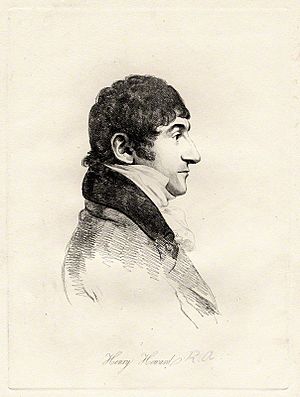Henry Howard (artist) facts for kids
Henry Howard (born January 31, 1769 – died October 5, 1847) was a famous British painter. He lived in the early 1800s. He was known for painting people (called portrait painting) and important historical events (called history painting). He was also a member of the Royal Academy, which is a big deal for artists!
Contents
Becoming an Artist
Henry Howard was born in London. He went to school in Hounslow. In 1786, when he was about 17, he started learning from a painter named Philip Reinagle.
Two years later, in 1788, he joined the Royal Academy Schools. This is a special art school. He won two important awards there:
- A silver medal for drawing from real life.
- A gold medal for a historical painting called Caractacus Recognising the Dead Body of his Son.
Travels and Family Life
In 1791, Henry Howard traveled to Italy, France, and Switzerland. While in Rome, he learned about sculpture from artists like John Flaxman. He even painted a picture called Dream of Cain in 1792.
After his father faced money problems, Henry asked the Royal Academy for help. He returned to Britain a couple of years later. He started teaching drawing to Jane Reinagle, who was his old teacher's daughter. They fell in love and got married in 1803. They had seven children together – four daughters and three sons. From 1806, they lived in Westminster until Henry passed away.
His Art and Career
In the 1790s, Henry Howard painted many different things. He painted scenes from books, portraits of people, and drawings of sculptures. He showed five of his paintings at the Royal Academy in 1795 and 1796. One of these was a sketch inspired by Milton's famous poem, Paradise Lost.
He also helped illustrate books, like editions of Pope's translation of Homer. He even created designs for Wedgwood's pottery, which is famous for its beautiful dishes.
Joining the Royal Academy
Henry Howard became an associate member of the Royal Academy in 1801. He showed his art there every year until he died. In 1808, he became a full member. This was a big achievement for him.
He took on important roles at the Academy:
- In 1811, he became the secretary.
- In 1833, he was named a professor of painting. His son, Frank, later published his father's lectures.
One of his special paintings for the Academy was The Four Angels Loosed from the Great River Euphrates. He also painted many scenes from Milton's play Comus and from Shakespeare's plays.
Important Works and Patrons
In 1809, he showed a painting called Christ Blessing Young Children. This painting later became the altarpiece (a piece of art behind an altar) for a church in London.
One of Henry Howard's most important supporters was Lord Egremont. Lord Egremont was a big art collector who bought many of Howard's paintings.
Henry Howard's history paintings followed a style called neo-classical academic art. This means they were inspired by ancient Greek and Roman art. Many of his portraits are displayed in the National Gallery.
You can still see some of his decorative work today. For example, his painting Aurora (from 1837) is on the ceiling of the dining room at the Sir John Soane's Museum.
Other Projects
Henry Howard also worked on many decorative projects. In 1805, he was asked to paint a frieze (a long, narrow band of art) called Cupid and Psyche.
He also created large, glowing pictures for a special event in Green Park. This event celebrated the defeat of Napoleon. These pictures were so big they were lit from behind!
In 1835, he painted a Solar System on the ceiling of Stafford House. This house had an amazing art collection that was open to the public. He worked on several other ceiling projects too.
Henry Howard died in Oxford on October 5, 1847.
Works
Two poems were written about Henry Howard's paintings by a writer named Letitia Elizabeth Landon.
- The first poem was about his painting The Hours in 1823.
- The second poem was about Fairies on the Sea Shore in 1825. This poem was later printed again in 1836 with an engraving of the painting.
Images for kids
-
Timon of Athens: Act I, Scene 2: Timon's prodigality; engraved by R. Rhodes after a painting by Henry Howard (1802)




